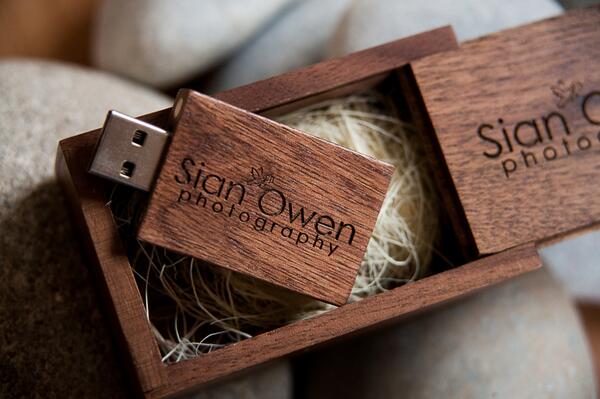Advice for Professional Photographers thinking of buying USB Memory Sticks
There has been a marked shift in the way in which professional photographers supply digital copies of their images. Fewer and fewer are using CD’s and DVD’s instead preferring to make them available on USB memory sticks or simply uploading them to a cloud based storage service from which their clients can download them.
Cloud based options are an easy and simple solution but they don’t really offer much in the way of driving additional revenue, building brand loyalty or giving the customer something really personal and tangible. In an increasingly competitive photography market it’s important for photographers to differentiate their service and in pure commercial terms it critical that every revenue opportunity is maximised. When you’re a professional you’re running a business and whilst some of the elite or privileged might be able to just focus on the photography for the rest it’s about earning enough to stay in a business they love and putting food on the table.
There are now some absolutely amazing USB packages available that have been put together specifically with the professional photographer but why buy these instead of just picking up a decent Kingston or Lexar drive from your local Staples or PC World Store?
The standard drives will do the job but they won’t exactly make anyone’s heart miss a beat if they’re given their wedding or family portfolios on one of them and charging a premium for them might be a challenge! Equally don’t expect to see lots of Facebook posts or Tweets about them and how they were blown away by them – these standard USB sticks are boring, they’re about function not flair, they’re not designed to lift peoples spirits they’re designed as a business tool.
Great photographs work on an emotional level so if you are going to use USB sticks to distribute them on then surely it’s best to use one that looks as though some care, creativity and thought has gone into its choice? Use one that reflects your own style and approach and works in harmony with your photographs and your typical clients.
When shopping for USB memory sticks here are some basic tips to help you:
- Find a specialist supplier - the vast majority of USB memory sticks suppliers are mainly selling them to companies that give will them away at trade shows and exhibitions or press events. These are usually cheap and cheerful flash drives that will have slow(ish) read/write speeds and will have limited branding and packaging options. Ideally find a supplier has a proved track record of supplying photographers, understands the industry and has developed a range of packages specifically for the photography sector.
- Buy a product that is fit for purpose - The typical read/write speeds of a “promotional USB sticks” is usually little more than 2MB per second (write) and 4MB per second (read). This is fine if they are just being data loaded with a couple of PDF sales brochures but, if you’re a professional photographer you will need to get USB sticks with better (upgraded) flash memory and better controller chips. If you don’t then be prepared to spend several hours copying your photographs onto each USB stick.
- Consider using the latest USB 3.0 sticks. USB 3.0 is the new standard for USB. USB sticks that use this standard will have read/write speeds of around 50MB – 100MB per second so they are very, very fast! They cost a little more than equivalent USB 2.0 sticks (but not as much as you might expect) but to take advantage of the speeds they offer you’ll need a PC or Mac that is equipped with USB 3.0 USB ports. Even if your clients only have PC’s with the older USB 2.0 USB port on them they will still be able to use them they’ll just run a bit slower. The real benefit is the time you’ll save loading the images onto the sticks.
- Get Physical Samples and Mock Ups – Ask for free samples to help you choose which model to go with and get your supplier to work up various mock-ups and examples for you. Again, a good supplier will have an in-house design team and they should be able to suggest and illustrate a number of options that will work with your brand or logo. Don’t pay for this. Mock-ups should be free and will not (should not) bind you to placing an order.
- Don’t forget the packaging – the style and type of box you choose can help lift the overall impact your USB sticks make when you hand them over to your client. Printed or engraved boxes are relatively inexpensive providing they are purchased with your USB sticks so make sure to ask about the available options.
- Check our what other photographers are saying about the supplier and their products – there are plenty of 3rd party review sites like Trustpilot that will help you to see what other customers are saying but there are also lots of “private” photography forums and boards where you can ask for advice or just read other threads/posts on this subject.
- Take all claims of “A Grade” USB and chips with a pinch of salt – every USB supplier now claims this and they get away with it because they know they are rarely ever challenged and when they are it’s often after an order has been placed and fulfilled. Better to trust what other customers are saying that taking the claims of the supplier at face value.


